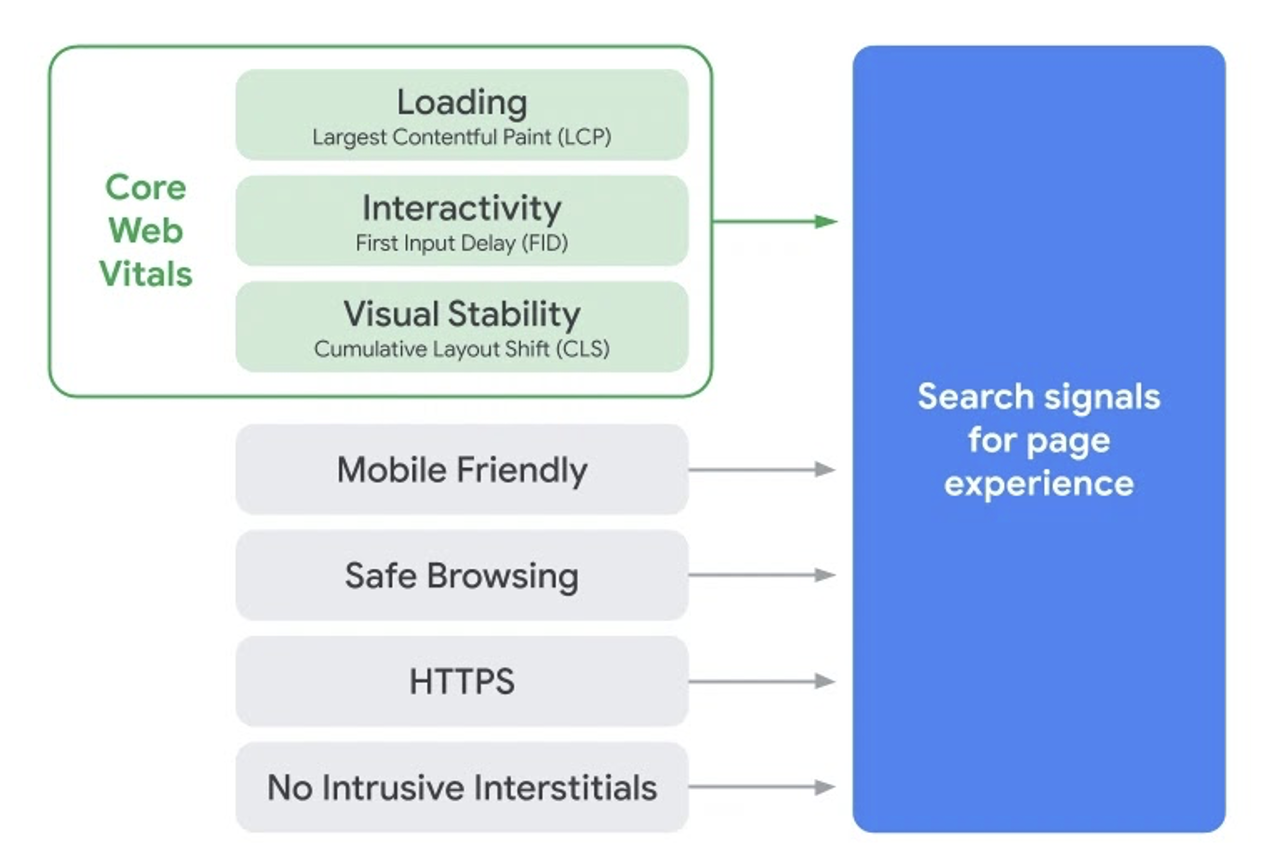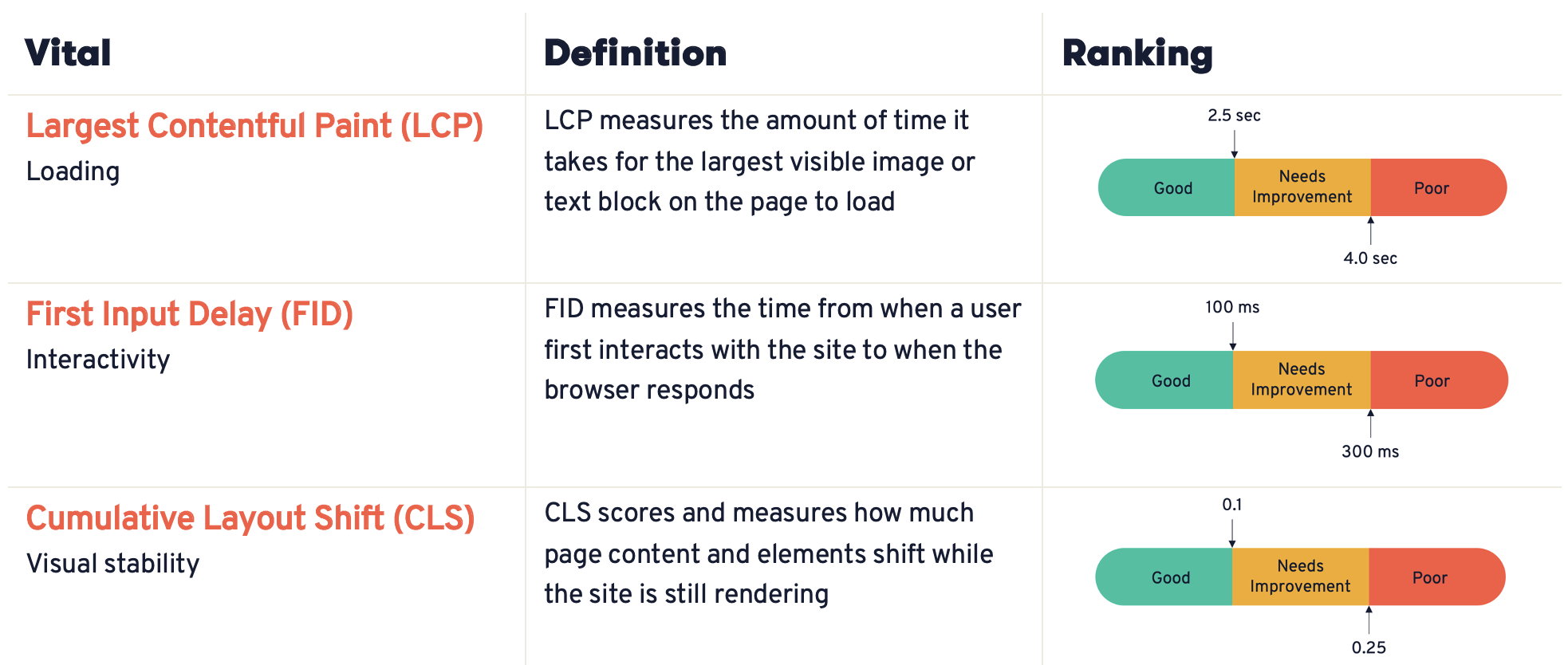Google’s Core Web Vitals Algorithm Update Nears
A handful of times each year, Google makes updates to its Core Algorithm, the fundamental building blocks that power Google’s search engine. To put it simply: these updates are a big deal. Every update Google makes is designed to optimize the experiences of searchers, but these changes can throw websites and SEO experts for a loop and dramatically impact the search engine results page (or affectionately named, the SERP).
With its upcoming update, Google is prioritizing user experience through updates to its Core Web Vitals, which measure a site’s performance according to a searcher’s experience when they land on a page. Starting for the first time in mid-June 2021, onsite user experience will officially be a ranking factor in the SERP. But according to Searchmetrics, only 4% of all websites are prepared for the update and rank as “good” among the top three Core Web Vitals.
Why is Google making these updates?
As user expectations continue to raise to higher and higher standards, most sites are not keeping up. In terms of optimization, it’s Google’s responsibility to optimize its search engine for users, and the SEO experts’ responsibility to optimize for search engines and users alike to ensure that webpages are ranking and reaching relevant searchers. With this in mind, these updates are simply Google’s way of telling the digital community that it’s time to begin prioritizing user experience. And there’s a lot of upside to doing so: Google has stated that if a website adheres to these new standards, visitors are 24% less likely to abandon the site.
Compared to 2020, Google has planned significantly more Core updates in 2021, indicating that it may have more big changes up its sleeve. In addition to this Core Web Vitals page experience signals update, Google has slated two other Core updates to roll out over June and July of 2021. However, it is important to note that these updates are much less significant and should not dramatically impact your site’s organic visibility if it is following SEO best practices. If Google’s algorithm were a car, these two minor updates are similar to an oil change and a tire rotation — not worth crying over. On the other hand, the page experience signal updates are more like a brake job — a bit expensive, but worth attending to in the long run.
First, what even are the Core Web Vitals?
The Core Web Vitals are the set of factors that Google deems important when it comes to page experience. In May of 2020, Google announced that page experience signals would be included in SERP rankings and Google would begin measuring mobile friendliness, safe browsing, HTTPS-security, and a lack of intrusive interstitials (pop-ups) to promote and prioritize better user experiences.
In November of 2020, Google added three new page experience signals that make up what they call the Core Web Vitals. These three vitals, which will be implemented in Google’s SERP ranking algorithm starting mid-June 2021, are Largest Contentful Paint (LCP), First Input Delay (FID), and Cumulative Layout Shift (CLS).

How will these vitals affect my website?
Each Core Web Vital has its own dimension of scoring based on what the vital is measuring. In order to pass Google’s Core Web Vitals and rank for user experience, your site must score a “Good” in all three categories. If a page does not pass, then it risks the ability to appear in organic search as Google’s algorithm may ultimately rank more usable pages above it. Below is a high-level breakdown on what these vitals are and what your site needs in order to pass:

The weight of this change will initially be small for all sites but will likely increase over time as more and more websites adopt Google’s best practices for adhering to its Core Web Vitals. That said, some verticals will be hit harder than others. For instance, websites that operate through monetization, such as news sites, will have a steeper hill to climb because of all of the ad placements layered into its content. Websites with simpler or less content will not be affected as dramatically.
Even if simpler websites will not be immediately or dramatically impacted, this update in June is not the first and, more than likely, will not be the last update Google makes to its algorithm to prioritize usability as a ranking factor. Collective Measures anticipates that Google will continue to add more elements to its page experience signals over time and ramp up future updates to other aspects of the Core algorithm, so the time to update your site is now.
How can I know ahead of time how my website will be impacted?
There are a handful of free tools provided courtesy of Google that can be used to check the current status of your site and determine which pages need optimizing to reach a “Good” rating:
- Google Search Console: Identify how each page ranks and the groups of pages that require optimization
- PageSpeed Insights: Diagnose lab and field issues on mobile and desktop pages
- Chrome UX Report: Customized reports on your site’s performance
- Chrome DevTools + Lighthouse: Measure and test page updates and optimizations locally in a lab setting
- Web Vitals Extension: Measure the Core Web Vitals metrics on your site in real time on Google Chrome
What do marketers need to know?
As we stated above, this Core Web Vitals update is not the first and will likely not be the last time that Google updates its algorithm to prioritize usability as a ranking factor. We anticipate that Google will continue to add elements to its list of page experience factors over time, so if you have not considered evaluating your website’s usability, the time to act is now. If your site’s organic visibility is being managed by Collective Measures, rest assured that our SEO experts are on top of these updates and working to ensure your site is prepared for the changes. To help you navigate immediate next steps, below is a list of our recommended action items:
Key takeaways
- Conduct an audit of your website. An audit will help evaluate the current state of your website and identify pages that need updating and optimizing.
- Use the findings of the website audit to inform page optimizations to obtain a “Good” score for all three of the Core Web Vitals to ensure your page continues to rank high in the SERP.
- Continue to evaluate and optimize your website to monitor its compliance with the Core Web Vitals and any other page experience factors that Google may implement over time.




